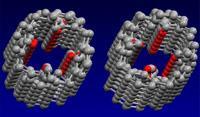New generation nanotubes could lead to nanowires and drug delivery systems
A host of reports from different laboratories has signalled renewed interest in self-assembling molecular nanotubes.
To create a hollow tube, one could either roll up a sheet, wind a wire helically around a cylinder, or stack a number of rings with equal diameter.
Twelve years ago, Reza Ghadiri and colleagues at the Scripps Research Institute, California, US, demonstrated the molecular version of the stacked rings approach.
Using peptide rings made of alternating D and L amino acids, the researchers showed that the hydrogen bonding pattern between the rings can be used to form stable nanotubes. By introducing charged residues in the side chains, they ensured that the assembly process could be controlled by simple pH shift.1
These self-assembling nanotubes were able to insert themselves into membranes, and thus to kill bacteria by making them leaky. Nevertheless, they have not received nearly as much attention over the last decade as the similarly sized graphite nanotubes.
Philippe M?sini and colleagues at the Institut Charles Sadron, Strasbourg, France, used a relatively simple diamide compound that forms gels from organic solvents such as dichloromethane. Using infrared spectroscopy, electron microscopy, and x-ray scattering, the researchers proved the aggregates found in the gel state consist of hollow tubes of around 24nm diameter. Detailed structural characteristics as well as the influence of chemical variations on the structure formation remain to be elucidated.2
Meanwhile, Rasika D?as and Dmitry Rudkevich at the University of Texas at Arlington, US, have created molecular nanotubes from a slightly more complex buiding block, a calix[4]arene. Their teams are mainly interested in the possibility of ’filling’ a nanotube with conductive or ionic material leading to a molecular wire.

They started their project from the observation that calixarenes can serve as hosts for the reactive nitrosonium (NO+) cation, and developed a simple alkylation mechanism to link the calixarenes together to form a hollow tube that could be readily filled with such ions.3
’Our nanotubes are covalently linked and therefore robust,’ said Rudkevich. ’They can be prepared by conventional organic chemistry protocols and their length can be controlled precisely and easily.’ In contrast to carbon nanotubes, which have to be opened
before they can be filled, the calixarene tubes ’can be easily
filled and form highly stable yet reversible encapsulation complexes.’
And finally Markus Biesalski at the Institute for Microsystems Technology at Freiburg, Germany, has used the classic Ghadiri design as a scaffold to construct peptide nanotubes coated in artificial polymers.
Their approach involved attaching a polymerisation
initiator to selected side chains of the cyclic peptides and allowing them to assemble into tubes, which could then be characterised in detail. The researchers dispersed the tubes in a solution containing
N-isopropylacrylamide (NIPAM) monomer, which polymerises by a free-radical mechanism in the presence of the initiators.4
The resulting polymer-coated nanotubes were around 80nm long and 12nm wide. Biesalski notes that, although the peptide design controls their assembly, ’the surface chemistry is governed exclusively by the polymer shell’.
While the investigation of the many possibilities to control their structure and surface properties is only beginning, Biesalski hopes
that such hybrid nanotubes might eventually find applications in
fields such as drug delivery, biosensing, tissue engineering, microfluidics or separation technology.
While research into graphite nanotubes has developed rapidly towards applications in electronics, the tubes have clear limitations that can hopefully be bypassed by the use of self-assembling molecular tubes based on cleverly designed building blocks.
Michael Gross
References
1 M R Ghadiri, Angew. Chem. Int. Ed., 2001, 40, 988
2 N Díaz et al, Angew. Chem. Int. Ed., 2005, (DOI 10.1002/anie200500536)
3 V G Organo et al, Angew. Chem. Int. Ed., 2005, 44, 3043
4 J Couet et al, Angew. Chem. Int. Ed., 2005, (DOI 10.1002/anie200462993)






No comments yet